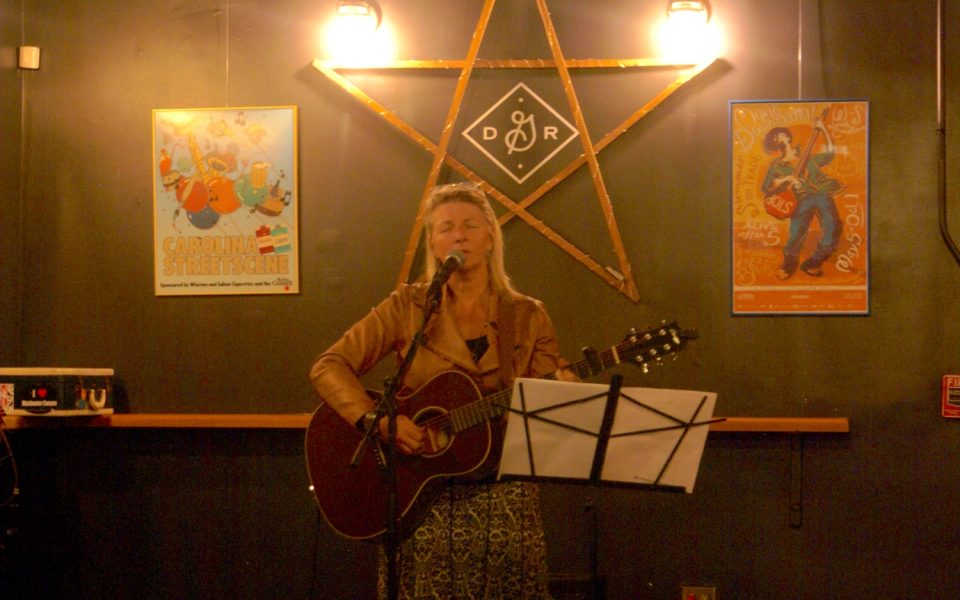The
fiddle and violin live as twins.
They
match down to the bow and strings — two different names for the same
instrument. Aside from a few minor variations sometimes found in some newer
versions, the separation comes down to style. One gets played in a symphony set
by composers, the other on back porches and in bluegrass festivals.
Laurelyn
Dossett now tries to bridge that gap, performing a preview of The Gathering on a cold Friday night at the
Gas Hill Drinking Room in Winston-Salem. Dossett performs the six-song long
cycle, taking listeners through a story of a daughter in her debate to return
home from her travels for the holiday season. The work merges classical music
with Appalachian roots, and acts as half of the Winston-Salem Symphony’s
upcoming Carolina Christmas concert.
“I
think of it more like a short folk opera,” Dossett said.
Dossett
sits in front of a small crowd, pausing in between songs to speak about the
music. Thanks to a grant from the NC Arts Council, as part of the Year of NC
Music, the Symphony and Dossett trace the two genres back to a time where they
more commonly intertwined. Many of the instruments used in bluegrass, folk and
other roots music historically find themselves in classical contexts, while
some now only differ in technique with their modern orchestral equivalents.
“The musics aren’t different,” Dossett said. “Everything about the categories they get put into are completely false and manmade.”
The Gathering acts as part of an effort from the
Winston-Salem Symphony to spotlight more local music. Travis Creed, general
manager of the symphony believes the purpose of the organization stretches past
performing classical pieces from famous composers or playing hour-long
orchestral works.
“I
think an orchestra is here to serve the community,” Creed said. “We want to serve
the community and show our community.”
Dossett
built the song cycle with the inclusion of a symphony in mind. The piece,
originally commissioned by the NC Symphony, leaves room for a string band, a
full chorus and a symphony by allowing the music to guide the story rather than
lyrics alone. Dossett also held tight to a few key themes she considers
touchstones to creating a Southern holiday scene.
“The
broader backdrop for all that family and connection,” Dossett said, “is, to me,
the pull of the moon in the winter night sky.”
Dossett
strums her guitar, ringing out a melody titled “Lights in the Lowlands” that
begins the song cycle. The lyrics act as a dialogue between a set of parents
and the prodigal daughter that Dossett sees as a motif of Southern Appalachian
stories. Images of a night sky and flickering town lights seen from atop a
mountain range appear as she works her way through the first song.
“There
are lights in the lowlands tonight,” she sings. “They’re a promise you’re never
alone.”
Among
the large chorus and symphony, four key instrumentalists keep the core of the
show firmly in roots music. Mike Compton on the mandolin, Joe Newburry on the
banjo and April Verch on the fiddle combine with Dossett’s guitar, making for a
sound that, aside from the banjo, could be found on a classical stage.
In
the height of The Gathering, Dossett
attempts to hop from line to line in a song titled “Red bird.” The song takes
the audience through the hustle of a large family celebration, using four
different main singers and lyrics laid on top of one another. From the names
used, to the images of children causing havoc and lengthy pre-dinner prayers
from grandparents, Dossett pulled the scene from her own family. Audience
members clap and stomp in bluegrass tradition, causing a slight echo for a
moment in the cozy venue.
“Red bird sing and call the gathering day,” she belts.
‘A Carolina Christmas’ is on Nov. 30th and Dec. 1st. Buy tickets and learn more at wssymphony.org/event/christmas/
Join the First Amendment Society, a membership that goes directly to funding TCB‘s newsroom.
We believe that reporting can save the world.
The TCB First Amendment Society recognizes the vital role of a free, unfettered press with a bundling of local experiences designed to build community, and unique engagements with our newsroom that will help you understand, and shape, local journalism’s critical role in uplifting the people in our cities.
All revenue goes directly into the newsroom as reporters’ salaries and freelance commissions.


Leave a Reply